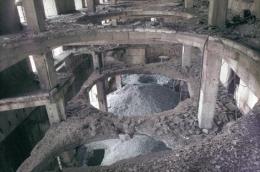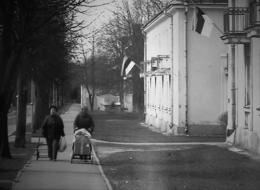2. MOSKVA KAASAEGSE KUNSTI BIENNAAL
PRESSITEADE 21.02.2007
2. Moskva kaasaegse kunsti biennaalil kunstnikud Eestist
01.03.2007 avatakse 2. Moskva Kaasaegse Kunsti Biennaal. Näituste-programmiga juba 17.02.2007 alustanud biennaali direktoriks on Joseph Bakštein ning peanäituste kuraatoriteks Joseph Bakštein, Daniel Birnbaum, Iara Boubnova, Nicolas Bourriaud, Fulya Erdemci, Gunnar B. Kyaran, Rosa Martinez ja Hans Ulrich Obrist.
Lisaks biennaali põhinäitustele toimub biennaali raames ka 25 kuraatoriprojekti ja erinevaid üritusi Moskva paljudel näitusepindadel. Lolita Jablonskiene (Kaasaegse Kunsti Teabekeskus, Vilnius) kuraatoriprojektis “Me tusameele monumendid: koha aeguvus / Monuments of our Discontent: Expiration of Place / Памятники тревоги нашей: истечение места”, mis leiab aset Art Center Winzavod´is, osalevad Eestist Liina Siib ja Eleonore De Montesquiou.
Biennaali põhinäitused ja projektid jäävad avatuks kuni 01. aprillini 2007.
Eesti kunstnike osalemist toetavad Kaasaegse Kunsti Eesti Keskus ja Eesti Kultuuriministeerium.

Liina Siib. “Le Carceri”. Lambda Print 1998/2007

Eleonore de Montesquiou. “Aatomilinnad. Paldiski-Sillamäe”. Video 2006
Lolita Jablonskiene kuraatoritekst:
Monuments of our Discontent: Expiration of Place
Памятники тревоги нашей: истечение места
Exhibition of the Second Moscow Biennale of Modern Art
Curated by Lolita Jablonskiene (Vilnius)
Organized by the Contemporary Art Information Center of the Lithuanian Art Museum (Vilnius)
Venue: Contemporary Art Center „Winzavod“ (Moscow)
In John Steinbeck’s “The Winter of Our Discontent” (1961) the character Ethan Hawley stops, on his way to work, to observe an old hotel that is being torn down and replaced with a Woolworths. The scenario is familiar as it presents a ‘modern condition’ of technology and power wielded by a predatory corporation bulldozing the old — that falls prey to the new. The allusion to Steinbeck’s book in my title and its master reference — from William Shakespeare’s “Life and Death of Richard III” — couples with the melancholy of a [man] struggling to find [his] place in a world marked by an excess of change, renewal and transformation. The threat posed to living, by constant reform, rings in the opening monologue by that personification of evil Prince Richard as he announces his veiled and cruel intent to relentlessly pursue his selfish desires and stop at nothing to achieve his wicked designs.
In today’s world, given the apposite moniker ‘Post-Cosmos’ by Pavel Pepperstein, destruction and re-construction has become a legitimate and widely applied technique of designing an ordered space – not a striving for an organized structure that opposes chaos but an embrace of a somewhat lunatic frenzy: of Capitalism globally re-establishing itself as a ‘capital’ power; of a tsunami of political tides; of a gossamer tracery of masterminded catastrophe; of ever creeping aggression… In this process, the grandeur of building a ‘glorious summer’ decorated with ‘victorious wreaths’ mirrors the dark ‘winter’ of brutal destruction — for the equivocal sake of making room for the new. And ‘New’ is today’s phantasmal imperative brand. The Post-Cosmos condition manifests itself globally and locally — it asserts the crumbling of the Modern Project, and spotlights the ill-gotten products of globalization, and accompanies the post-communist turmoil.
The contemporary urban landscape stands out as a fabric woven from shining monuments of industrial culture and their antithesis – visually offensive places encrusted with the rust and decay of the modern. In the new millennium, everything doomed to wear itself out and becomes useless — machines, buildings, and infrastructures — are doing so at an accelerating rate which virtually projects obsolescence. Monumental scale construction that is often too heavy to be removed and too dangerous to be demolished is left abandoned (with and without intent) to radiate exhaustion: becoming symbols of failure and impotence. These behemoths compound past with present and the present with the absent. These shell-like structures, places infused with absence, are then, in turn, potentially governed by imagination.
Lolita Jablonskienė
In the exhibition contemporary artists from the Baltic and Nordic countries, Armenia, Belarus, Moldova, Afghanistan and The Netherlands present works that articulate aspects of this thesis. The project focuses on the processes of reconstruction and readjustment in general as well as their relation specifically to contemporary post-soviet space.
The list of artists, includes: Nomeda & Gediminas Urbonas (LT), Kristina Inciuraite (LT), Kaspars Goba (LV), Rasa Smite, Raitis Smits, Martins Ratniks / RIXC and Lauris Vorslavs, Girts Radzins / Clausthome (LV), Eleonore De Montesquiou (FR/EE), Liina Siib (EE), Anu Pennanen (FI), Carl Michael von Hausswolff & Thomas Nordanstad (SE), Joachim Koester (DK), Bik Van der Pol (NL), Artur Klinau (BY), Vladimir Tsesler & Sergei Voichenko (BY), Pavel Braila (MD), Tigran Khachatrian (ARM), Lida Abdul (AF).